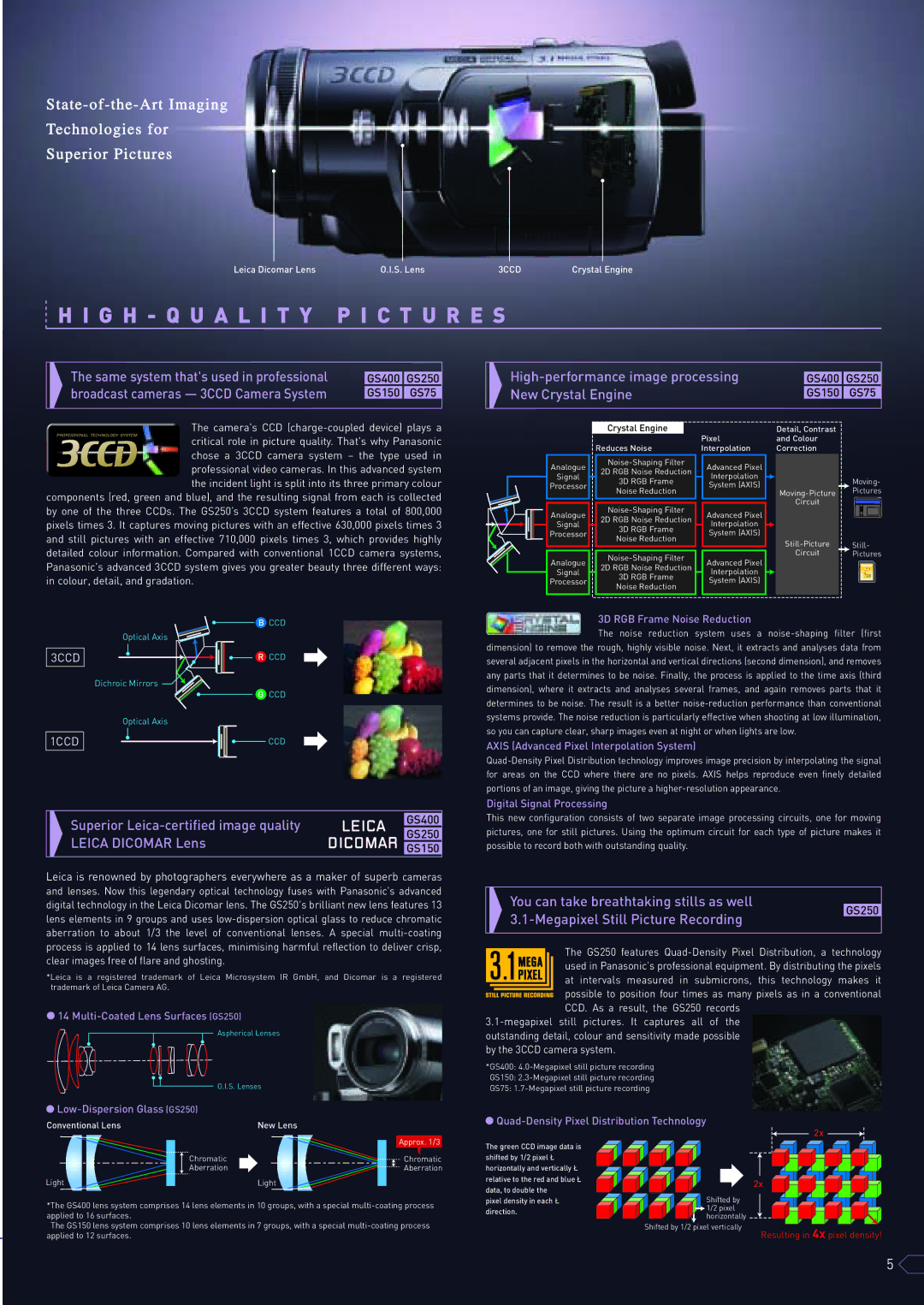
Technologies for
Superior Pictures
Leica Dicomar LensO.I.S. Lens3CCDCrystal Engine
 H I G H - Q U A L I T Y P I C T U R E S
H I G H - Q U A L I T Y P I C T U R E S
The same system that's used in professional |
|
|
|
GS400 | GS250 | ||
broadcast cameras — 3CCD Camera System |
|
|
|
GS150 | GS75 | ||
|
|
|
|
The camera's CCD
critical role in picture quality. That's why Panasonic
chose a 3CCD camera system – the type used in
![]()
![]()
![]()
![]()
![]()
![]()
![]() professional video cameras. In this advanced system the incident light is split into its three primary colour components (red, green and blue), and the resulting signal from each is collected
professional video cameras. In this advanced system the incident light is split into its three primary colour components (red, green and blue), and the resulting signal from each is collected
by one of the three CCDs. The GS250’s 3CCD system features a total of 800,000 pixels times 3. It captures moving pictures with an effective 630,000 pixels times 3 and still pictures with an effective 710,000 pixels times 3, which provides highly detailed colour information. Compared with conventional 1CCD camera systems, Panasonic's advanced 3CCD system gives you greater beauty three different ways: in colour, detail, and gradation.
| B CCD |
| Optical Axis |
3CCD | R CCD |
| Dichroic Mirrors |
| G CCD |
| Optical Axis |
1CCD | CCD |
|
|
| |
GS400 | GS250 | ||
New Crystal Engine | GS150 |
| GS75 |
|
| ||
|
|
|
|
| Crystal Engine |
| Detail, Contrast |
| |
|
| Pixel | and Colour |
| |
| Reduces Noise | Interpolation | Correction |
| |
Analogue | Advanced Pixel |
|
| ||
2D RGB Noise Reduction |
|
| |||
Signal | Interpolation |
|
| ||
3D RGB Frame |
| Moving- | |||
Processor | System (AXIS) |
| |||
Noise Reduction | Pictures | ||||
|
| ||||
|
| Circuit |
| ||
Analogue | Advanced Pixel |
|
| ||
2D RGB Noise Reduction |
|
| |||
Signal | Interpolation |
|
| ||
3D RGB Frame |
|
| |||
Processor | System (AXIS) |
|
| ||
Noise Reduction |
|
| |||
|
| Still- | |||
|
|
| |||
Analogue | Advanced Pixel | Circuit | Pictures | ||
|
| ||||
2D RGB Noise Reduction |
|
| |||
Signal | Interpolation |
|
| ||
3D RGB Frame |
|
| |||
Processor | System (AXIS) |
|
| ||
Noise Reduction |
|
| |||
|
|
|
|
3D RGB Frame Noise Reduction
The noise reduction system uses a
AXIS (Advanced Pixel Interpolation System)
|
| |
Superior | GS400 | |
| ||
GS250 | ||
LEICA DICOMAR Lens | ||
| ||
GS150 | ||
| ||
|
|
Leica is renowned by photographers everywhere as a maker of superb cameras and lenses. Now this legendary optical technology fuses with Panasonic's advanced digital technology in the Leica Dicomar lens. The GS250's brilliant new lens features 13
Digital Signal Processing
This new configuration consists of two separate image processing circuits, one for moving pictures, one for still pictures. Using the optimum circuit for each type of picture makes it possible to record both with outstanding quality.
You can take breathtaking stills as well
lens elements in 9 groups and uses
3.1-Megapixel Still Picture Recording
GS250
clear images free of flare and ghosting.
*Leica is a registered trademark of Leica Microsystem IR GmbH, and Dicomar is a registered trademark of Leica Camera AG.
•14
![]() Aspherical Lenses
Aspherical Lenses
O.I.S. Lenses
•Low-Dispersion Glass (GS250)
Conventional Lens | New Lens |
Approx. 1/3
Chromatic | Chromatic |
Aberration | Aberration |
Light | Light |
*The GS400 lens system comprises 14 lens elements in 10 groups, with a special
The GS150 lens system comprises 10 lens elements in 7 groups, with a special
The GS250 features
possible to position four times as many pixels as in a conventional CCD. As a result, the GS250 records
*GS400:
•Quad-Density Pixel Distribution Technology
2x
The green CCD image data is |
| |
shifted by 1/2 pixel Ł |
| |
horizontally and vertically Ł |
| |
relative to the red and blue Ł | 2x | |
data, to double the | ||
| ||
pixel density in each Ł | Shifted by | |
direction. | 1/2 pixel | |
horizontally | ||
|
Shifted by 1/2 pixel vertically
Resulting in 4x pixel density!
5 ![]()
